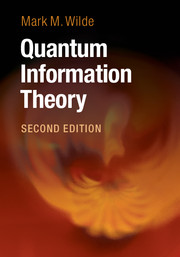Book contents
- Frontmatter
- Contents
- Preface to the Second Edition
- Preface to the First Edition
- How To Use This Book
- Part I Introduction
- Part II The Quantum Theory
- Part III Unit Quantum Protocols
- Part IV Tools of Quantum Shannon Theory
- Part V Noiseless Quantum Shannon Theory
- Part VI Noisy Quantum Shannon Theory
- Introduction
- 20 Classical Communication
- 21 Entanglement-Assisted Classical Communication
- 22 Coherent Communication with Noisy Resources
- 23 Private Classical Communication
- 24 Quantum Communication
- 25 Trading Resources for Communication
- 26 Summary and Outlook
- Appendix A Supplementary Results
- Appendix B Unique Linear Extension of a Quantum Physical Evolution
- References
- Index
22 - Coherent Communication with Noisy Resources
from Part VI - Noisy Quantum Shannon Theory
Published online by Cambridge University Press: 16 February 2017
- Frontmatter
- Contents
- Preface to the Second Edition
- Preface to the First Edition
- How To Use This Book
- Part I Introduction
- Part II The Quantum Theory
- Part III Unit Quantum Protocols
- Part IV Tools of Quantum Shannon Theory
- Part V Noiseless Quantum Shannon Theory
- Part VI Noisy Quantum Shannon Theory
- Introduction
- 20 Classical Communication
- 21 Entanglement-Assisted Classical Communication
- 22 Coherent Communication with Noisy Resources
- 23 Private Classical Communication
- 24 Quantum Communication
- 25 Trading Resources for Communication
- 26 Summary and Outlook
- Appendix A Supplementary Results
- Appendix B Unique Linear Extension of a Quantum Physical Evolution
- References
- Index
Summary
This chapter demonstrates the power of both coherent communication from Chapter 7 and the particular protocol for entanglement-assisted classical coding from the previous chapter. Recall that coherent dense coding is a version of the dense coding protocol in which the sender and receiver perform all of its steps coherently.1 Since our protocol for entanglement-assisted classical coding from the previous chapter is really just a glorified dense coding protocol, the sender and receiver can perform each of its steps coherently, generating a protocol for entanglement-assisted coherent coding. Then, by exploiting the fact that two coherent bits are equivalent to a qubit and an ebit, we obtain a protocol for entanglement-assisted quantum coding that consumes far less entanglement than a naive strategy would in order to accomplish this task. We next combine this entanglement-assisted quantum coding protocol with entanglement distribution (Section 6.2.1) and obtain a protocol for quantum communication at a rate equal to the channel's coherent information (Section 13.5). This sequence of steps demonstrates an alternate proof of the direct part of the quantum capacity theorem stated in Chapter 24.
Entanglement-assisted classical communication is one generalization of superdense coding, in which the noiseless qubit channel becomes an arbitrary noisy quantum channel while the noiseless ebits remain noiseless. Another generalization of super-dense coding is a protocol named noisy super-dense coding, in which the shared entanglement becomes a shared noisy state ρAB and the noiseless qubit channels remain noiseless. Interestingly, the protocol that we employ in this chapter for noisy super-dense coding is essentially equivalent to the protocol from the previous chapter for entanglement-assisted classical communication, with some slight modifications to account for the different setting. We can also construct a coherent version of noisy super-dense coding, leading to a protocol that we name coherent state transfer. Coherent state transfer accomplishes not only the task of generating coherent communication between Alice and Bob, but it also allows Alice to transfer her share of the state ρAB to Bob.
- Type
- Chapter
- Information
- Quantum Information Theory , pp. 600 - 623Publisher: Cambridge University PressPrint publication year: 2017



